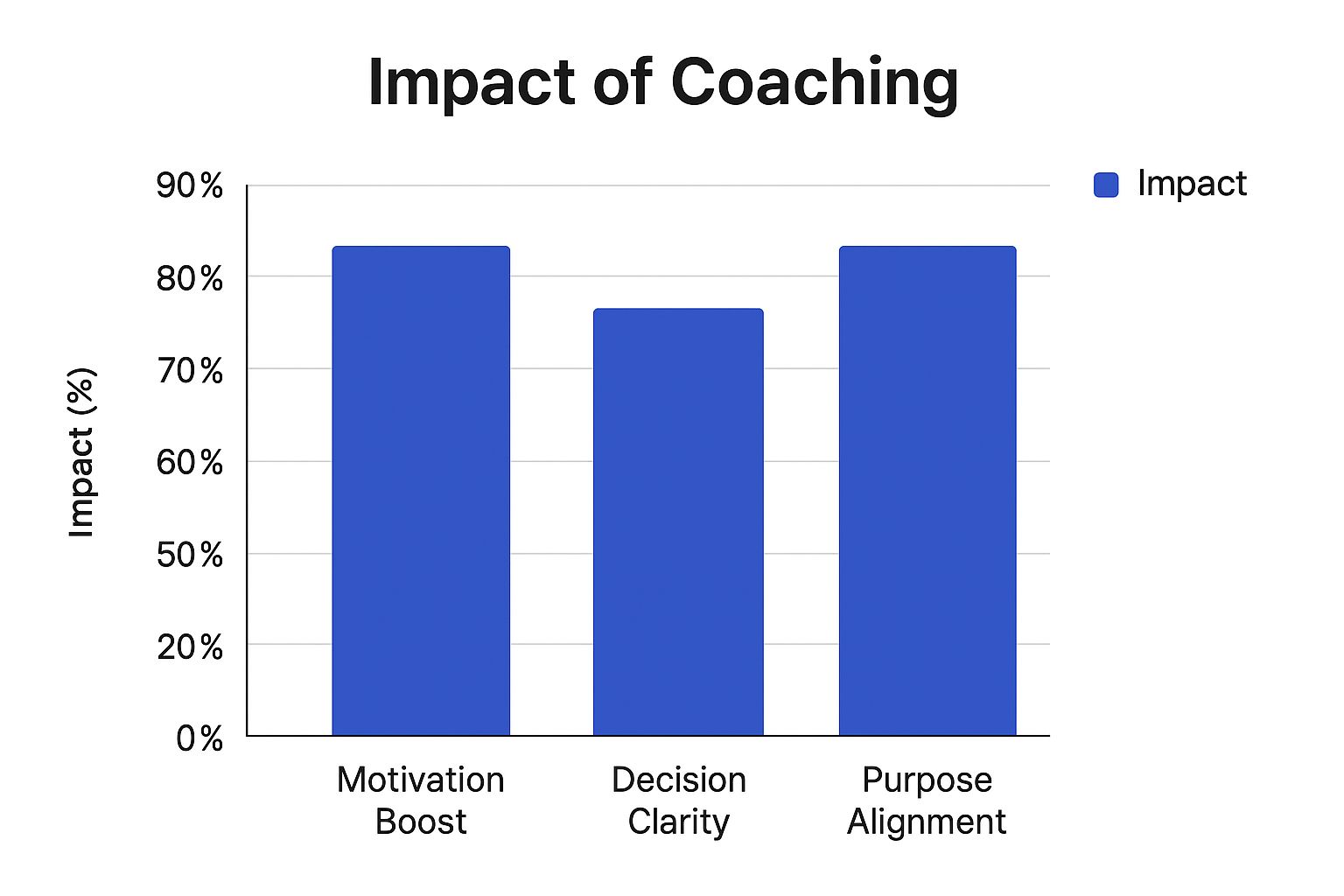A personal mission statement connects the dots between your core values, passions, and unique strengths. It’s a short, actionable declaration that answers three questions: What do I do? Who do I do it for? And what impact do I want to have?
Think of it as your personal compass for making decisions, an actionable tool to guide you from where you are to where you want to go.
Why Your Personal Mission Statement Matters (Understanding Purpose)
Ever feel like you’re drifting, making choices that don’t quite feel… right? A personal mission statement is more than a corporate buzzword; it’s your guide for navigating life and career with clarity and confidence. This isn’t an abstract philosophical exercise; it’s a practical tool for defining your own true north.
Essentially, it becomes the foundational document for your life, keeping you laser-focused on what really matters. It acts as a filter for opportunities and a wellspring of motivation when you inevitably feel stuck. The benefits are tangible, directly feeding your focus and drive.
The Impact on Your Life
A well-crafted statement does three key things that add up to a more fulfilling life.
- It boosts your motivation. Suddenly, daily tasks connect to a bigger picture. Practical Example: Instead of just “coding an app,” you’re “building tools that help artists sell their work,” which links directly to your mission of supporting creativity.
- It simplifies decisions. When a choice comes up, you ask, “Does this align with my mission?” Actionable Insight: If your mission is about promoting sustainability, choosing between two job offers becomes easier—one at a fast-fashion brand and another at a B Corp.
- It aligns your actions with your purpose. This ensures that what you do today builds toward your long-term vision. You can dig deeper into this connection by exploring our guide on how to find your life purpose.
This chart gives a great visual of the powerful impact a clear mission can have on your motivation, decision-making, and overall sense of purpose.

The data speaks for itself. Purpose alignment sees the highest impact, showing how a mission statement closes the gap between your daily grind and your deepest values.
And this isn’t just an intellectual exercise—it has a direct effect on morale and productivity. A recent case study documented a training session where employees drafted their own mission statements. The result? Measurable jumps in team performance and morale. You can read the full study about these mission statement findings to see exactly how this practice translates into real-world results.
Begin Your Self-Discovery Journey
Before you write a personal mission statement, you need to gather the raw materials. This is about actionable introspection to uncover the fundamental building blocks of who you are: your values, passions, and unique strengths.
Think of these as the ingredients for your personal recipe for fulfillment.
This foundational work is non-negotiable. If you skip this part, your statement will feel hollow and generic. The goal is to create a declaration so authentic it could only belong to you.

Pinpoint Your Core Values
Core values are the non-negotiable principles guiding your decisions, even when no one is watching. They’re your internal compass. Trying to live a life that conflicts with them is a surefire recipe for burnout.
- Actionable Insight: Grab a piece of paper and brainstorm a list of words that resonate with you. Don’t overthink it. Think about big ideas like:
- Integrity: Being honest and having strong moral principles.
- Creativity: Using imagination or original ideas to create something new.
- Growth: A deep commitment to continuous learning and self-improvement.
- Connection: Valuing deep, meaningful relationships with others.
Once you have a big list, circle your top five. These are the values that feel absolutely essential. If you’re struggling to narrow it down, sometimes an outside perspective helps. Consider taking a quiz to help you discover your purpose and uncover what truly drives you.
Key Insight: Your values define your operational ethics. When a decision aligns with your top five values, it almost always feels right. When it doesn’t, you feel that sense of internal conflict. This is your mission statement’s guidance system in action.
Uncover Your Passions and Strengths
With your values defined, it’s time to explore what genuinely energizes you and what you’re naturally good at. Passions are the activities that make you feel alive, while strengths are your innate talents and hard-won skills.
- Actionable Insight: Ask yourself targeted questions. What problems in the world do you want to solve? What topics could you talk about for hours without getting bored?
- Practical Example: Your passion might be mentoring young professionals, and a key strength could be your ability to simplify complex ideas. A powerful mission statement connects these two things, turning them into a purposeful action.
Understanding this distinction is crucial for crafting a statement that is both inspiring and grounded in reality.
Differentiating Your Core Components
This table should help clarify the differences between these core components and how they fit together.
| Component | Definition | Example |
|---|---|---|
| Core Values | Your fundamental beliefs and guiding principles. | Honesty, compassion, curiosity. |
| Passions | Activities or topics that energize and excite you. | Teaching, environmental conservation, coding. |
| Strengths | Your natural talents and learned abilities. | Public speaking, data analysis, empathy. |
Seeing them laid out like this makes it easier to spot the unique threads you’ll weave into your mission statement. It’s the intersection of your guiding values, what you love to do, and what you’re good at that creates a truly powerful foundation.
Drafting a Statement That Inspires Action (The Self-Discovery Journey)
You’ve done the deep work of digging into your values, passions, and strengths. Now it’s time to assemble those raw materials into a powerful declaration. This isn’t about writing poetry; it’s about crafting a concise, memorable statement that feels like your own personal mantra.
Think of it as a simple but potent formula: Action + Audience + Outcome. This structure is your bridge from abstract ideas to an actionable sentence. The goal is a statement that’s both authentic and directional.

Building Your Statement Sentence by Sentence
Let’s get practical and break down that formula. These sentence starters are just a launchpad—tweak them until the words feel completely your own.
- To use my [strength] to help [audience] achieve [outcome].
- To create [impact] for [audience] by leaning into my [passion].
- My purpose is to empower [audience] with [my unique skill] so they can [desired result].
This isn’t just self-help fluff. It’s the same approach effective organizations use. Research on corporate missions shows that the most successful companies focus on their self-concept, core values, and public image—not just profits. Authenticity and a clear identity are everything.
Real-World Examples in Action
Seeing how others articulate their purpose is the best way to get your own creative juices flowing. A great mission statement is specific enough to feel meaningful but broad enough to give you room to grow. For a longer list of ideas, check out these inspiring life purpose examples.
- Practical Example (Software Developer): “To use my problem-solving skills to build intuitive technology that helps creative entrepreneurs streamline their businesses.”
- Practical Example (Community Organizer): “To empower marginalized communities by creating accessible platforms for their voices to be heard and valued.”
- Practical Example (Financial Planner): “To provide clear, empathetic financial education that enables young families to build generational wealth and security.”
Notice how each one clearly defines an action, an audience, and an intended outcome. Don’t stress about getting this perfect on the first try. The point is to draft a version that feels true right now.
Overcoming Common Writing Blocks
It’s normal to hit a wall when trying to distill your life’s purpose into a few sentences. This is where most people get spooked. Instead of aiming for a perfect, profound final draft, think of this as a creative warm-up.
The biggest hurdle is that blinking cursor on a blank page, coupled with the immense pressure to write something meaningful. The trick is to just get it all out—without judgment.
Tame the Overwhelm with a Brain Dump
Feeling like you have too many ideas is a great place to start. Don’t try to filter or organize them yet. Instead, lean into the chaos with a brain dump.
- Actionable Insight: Set a timer for 10-15 minutes. Grab a notebook and write. Pour out every single word, phrase, or half-baked concept related to your purpose.
- The only rule is to keep your pen moving until that timer goes off. This simple act gets the raw materials out of your head and onto the page where you can see what you’re working with.
Pro Tip: Your first draft is not your final draft. Its only job is to exist. Give yourself permission to write a messy, chaotic, and imperfect version. The polishing comes later.
Push Past Perfectionism and Find Your “Why”
Once you have a mess of a brain dump, the next challenge is shaping it. This is where perfectionism can grind your progress to a halt. If your words feel generic, it’s a sign you need to dig deeper.
- Actionable Insight: Use the ‘Five Whys’ exercise. Start with a statement from your brain dump (like “I want to help people”) and ask “Why?” five times, getting more specific with each answer.
- Practical Example:
- Statement: I want to help small businesses succeed.
- Why? Because I admire their passion and grit.
- Why? Because they create something unique for their communities.
- Why? Because strong local communities give people a sense of belonging.
- Why? Because that feeling of belonging is fundamental to human connection.
- Why? Because I truly believe that deep connection is the foundation of a fulfilling life.
And just like that, a generic goal (“help small businesses”) unearths a powerful core value: fostering connection. This is the deep, personal insight that transforms a mission statement from a bland platitude into a genuine reflection of who you are.
Bringing Your Mission to Life Daily (Purpose in Practice)
A beautifully crafted personal mission statement means little if it gathers dust in a notebook. Its true power is unlocked when you move it from the page into your actual, real-life decisions. This is about turning those words into a practical filter for your choices.

This transition from idea to action doesn’t require a massive life overhaul. Instead, it’s about creating small, consistent touchpoints that keep your purpose front and center, transforming a simple sentence into a powerful tool for building an intentional life.
Weave Your Mission Into Your Routines
To make your mission a living part of your life, you need to see it regularly. Out of sight is out of mind. The goal is to make it an automatic reference point.
- Actionable Insight: Make it visible. Set your mission statement as your phone’s lock screen or computer wallpaper.
- Actionable Insight: Book a recurring weekly 5-minute meeting in your calendar to read and reflect on it.
- Actionable Insight: Read your mission statement aloud each morning before checking email. Let it frame your day.
This consistent exposure reinforces your commitment and turns your statement into an active guide rather than a passive document.
Think of your mission statement as your personal decision-making algorithm. Before saying “yes” to a new project or commitment, ask a simple question: “Does this move me closer to my mission?” If the answer is a clear “no,” or even a hesitant “maybe,” you have your answer.
This practice is vital in your professional life. When you can draw a clear line between your personal mission and your daily work, your engagement skyrockets. Gallup research shows that when employees feel this connection, turnover can be reduced by 8.1% and profitability can increase by 4.4%. Imagine applying that same boost to your own life and career.
Common Questions About Personal Missions
As you start to craft your personal mission statement, a few questions almost always pop up. That’s a good thing. Think of this process as an ongoing conversation with yourself.
How Often Should I Revisit My Mission Statement?
It’s a fantastic practice to check in with your statement at least once a year. You should also pull it out anytime you’re facing a major life transition—a career change, a move, or starting a new family chapter.
Your mission isn’t meant to be carved in stone. As you grow and your priorities shift, your mission should evolve with you. Treat it like a compass that needs recalibration to keep you pointed true north.
What Is the Difference Between a Mission and a Vision Statement?
The simplest way to think about it is through the lens of time: your mission is about the present, and your vision is about the future.
- A mission statement is your operational guide. It defines what you do, who you serve, and why you do it right now. It’s the “how” behind your daily actions.
- A vision statement is your destination. It’s a vivid picture of the ideal future you’re working to create. It’s the ultimate “why” that pulls you forward.
Basically, your mission is the path you walk every day, while your vision is the mountain peak you’re climbing toward.
Key Takeaway: Your mission statement grounds you in your present purpose, answering, “How will I act today?” Your vision statement lifts your gaze to the future, answering, “Where am I ultimately going?” Both are incredibly valuable, but your mission is your daily guide.
Can My Mission Statement Be More Than One Sentence?
Absolutely. Please don’t get hung up on forcing your entire purpose into a single, perfect sentence.
While a concise, one-sentence statement is powerful and easy to remember, the most important thing is that it feels authentic and inspiring to you.
A strong mission statement often lands between one and three sentences. If it takes a short paragraph to truly capture your “why,” your core values, and the impact you want to have, that is perfectly fine. The real goal here is clarity and a deep personal connection, not sticking to an arbitrary rule.
Ready to move beyond questions and start building a life that truly aligns with what matters most to you? The tools and exercises at How To Find Your Life Purpose are designed to help you connect all these dots. Start your journey today at https://findyourlifepurpose.org.
Article created using Outrank